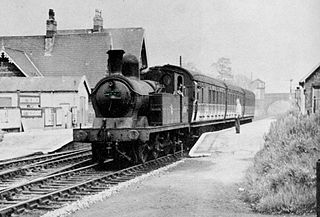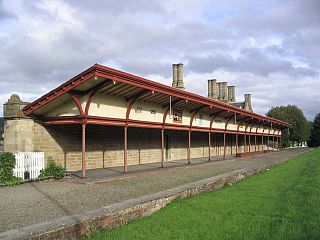
There are eleven disused railway stations between Exeter St Davids and Plymouth Millbay, Devon, England. At eight of these there are visible remains. Of the eleven stations, South Brent and Plympton are subject of campaigns for reopening while Ivybridge station was replaced by another station on a different site.
The railway branch line from Newton Abbot to Kingswear in Devon, England, is unusual as a large majority of the stations are still open for traffic. Of the eleven stations, seven are still open so there are only four disused railway stations on this line, a much lower proportion than most similar lines that do not serve big cities.

Northenden railway station in Sharston, Manchester, England, was built by the Stockport, Timperley and Altrincham Junction Railway (ST&AJ) and opened for passenger and goods traffic on 1 February 1866.
Lower Edmonton railway station was a station in Edmonton, London opened in 1849 by the Eastern Counties Railway as part of the original Enfield Town branch line. Originally named Edmonton it was renamed as Lower Edmonton low level to distinguish it from neighbouring Lower Edmonton high level. It closed to passengers in 1939 although the line on which it stood lasted until 1964.
Tweedmouth railway station was a railway station which served the Tweedmouth area of Berwick-on-Tweed in Northumberland, England. It was located on the East Coast Main Line. As well as a railway station for passengers, it was also the main service yard and goods yard between Newcastle upon Tyne and Edinburgh. Also Tweedmouth station was the terminus for the Tweed Valley Railway line, which connected the East Coast Main Line with the Waverley Line at Newtown St. Boswells. The station lies to the south of the Royal Border Bridge.

Bentley railway station, also known as Bentley Junction between 1849 and 1878, was located in Bentley, Suffolk on the Great Eastern Main Line. It opened in 1846 and became a junction in 1847 when the Hadleigh Railway opened. The station was closed in 1966.

Elham railway station is a disused railway station on the Elham Valley Railway which served the village of Elham in Kent and the surrounding villages. Situated to the east of Elham the clapboard station was opened in 1887. In 1931 the line was singled and one platform was closed. Regular passenger services were withdrawn on 1 December 1940 when the line was taken over for military use. In 1946 the line was reopened for goods traffic but a year later this service ceased when the station was officially closed. After closure the station building was demolished but one platform still exists forming a retaining wall of a garden for a house now built on the station site.

Belses railway station served the village of Belses, Scottish Borders, Scotland from 1849 to 1969 on the Waverley Route.
Cadishead railway station was a railway station on the Cheshire Lines Committees Glazebrook East Junction to Skelton Junction Line serving the village of Cadishead, near Irlam, Greater Manchester.

Melrose railway station served the town of Melrose, Roxburghshire, Scotland from 1849 to 1969 on the Waverley Route.

The Railway of Kelso and Jedburgh branch lines was a 'network' of three distinct railway services serving Kelso in the Scottish Borders.

Chevington railway station served the village of West Chevington, Northumberland, England from 1847 to 1964 on the East Coast Main Line.

Longhirst railway station served the village of Longhirst, Morpeth, England from 1847 to 1964 on the East Coast Main Line.

Choppington railway station served the village of Choppington, Northumberland, England from 1858 to 1964 on the Blyth and Tyne Railway.

Brancepeth railway station served the village of Brancepeth, County Durham, North East England from 1857 to 1964 on the Durham to Bishop Auckland Line.

Witton-le-Wear railway station is a railway station on the Weardale heritage railway serves the village of Witton-le-Wear in County Durham, North East England, and is the penultimate stop for most of line's eastbound passenger services. The current station platform is located on the opposite side of the track to the original railway station which was operation between 1847 and 1953.
Wear Valley Junction railway station primarily served as an interchange between the Wear Valley Line and the Weardale Extension Railway (WXR) between 1847 and 1935. It was the closest railway station to the village of High Grange in County Durham, North East England.
Sprouston railway station served the village of Sprouston, Scottish Borders, Scotland, from 1849 to 1965 on the Kelso Branch.

Sunilaws railway station served the parish of Carham, Northumberland, England, from 1859 to 1965 on the Kelso Branch.
Norham railway station served the village of Norham, Northumberland, England, from 1849 to 1965 on the Kelso Branch.













